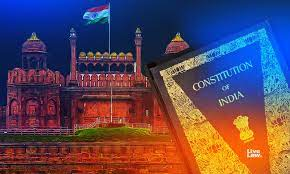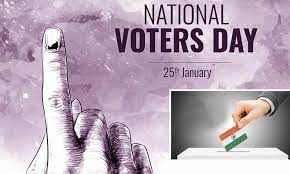

Republic Day is the day when the constitution of India was adopted by the Constituent Assembly. India became a Republic country on 26th January, 1950. It is the celebration of the empowerment of Indian citizens to select their own government. Indeed, it is a national holiday which commemorates the Indian Constitution.
In schools, children learn about the Indian Constitution and the years of hard work on it to make it successful.
The Republic is governed in terms of the Constitution of India which was adopted by the Constituent Assembly on 26th November, 1949 and came into force on 26th January,1950. The Constitution provides for a Parliamentary form of government which is federal in structure with certain unitary features. The constitution was drafted by the Constituent Assembly, which was elected by elected members of the provincial assemblies. The 389 member assembly (reduced to 299 after the partition of India) took almost three years to draft the constitution, holding eleven sessions over a 165 day period. The constitution of India was written by Bhimrao Ramji Ambedkar. He is known as the ‘Father of Indian Constitution’.
Other Members who contributed to the Constitution:
The Constitution is a set of rules and regulations which helps to guide the administration of a country.
The constitution is important to rule a nation and to make sure if everyone has equal rights of what they deserve.
Our Indian Constitution is the world’s longest hand-written document; its English version has a total of 117369 words. It is the most detailed constitution of the world which consists of 395 articles which has now increased to 448 articles.
The Indian Constitution has few features borrowed from other countries since we wanted to come up with a faultless system. Our philosophy of accepting good in others and posing no hesitation to learn the experiences of other nations,has helped us in framing many principles in their right sense and need.
Our Indian Constitution selected those features of other constitutions which suited Indian problems. The Constituent Assembly deduced the best features from everywhere and made them its own. Our constitution is a unique document which is a hard work of three years. It is made considering the historical perspective of Indian Nationalist struggles, geographical diversity, its traditionality and characteristics.
One of the unique features of our constitution is that it is not as rigid or flexible as the constitution of America or British respectively. Hence it can easily change and grow with the change of times.
The constitution was made on Ambedkar’s point of view and now there have been many changes based on the different situations that came up. There is a procedure to change as well as to add. An amendment of the Constitution can be initiated only by the introduction of a Bill in either House of Parliament. The Bill must then be passed in each House by a majority of the total membership of that House and by a majority of not less than two-thirds of the members of that House present and voting.
The Constitution serves as guidelines for every citizen.It helped India to attain the status of Republic in the world. Once Atal Bihari Vajpayee said that “Governments would come and go, political parties would be formed and dissolved, but the country should survive, and democracy should remain there forever”. The Constitution is the holy book of the Indian Republic. The essence of the Constitution is what makes India one of the strongest nations in the world.
- Debasmita Das, X
This year’s Republic Day is the 75th year of India’s Independence being celebrated as “AZADI KA MAHOTSAV”. India celebrated its 73rd Republic Day this year.
The first Republic Day was celebrated on 26thJanuary,1950. The chief guest of the first ever Republic Day Celebration was President Sukarna (President of Indonesia).
The parade is organized by the Ministry of Defence. The parade marches from the Rashtrapati Bhawan along the Rajpath to India Gate and from there to Red Fort.The procession displays regiments from the country’s military and vibrant tableaux from the states. This tradition has been followed since 1950.
This year India witnessed the grandest fly past ever featuring 75 aircraft including 5 Rafale. There were 21 tableaus from 12 states and 9 government institutions selected by an expert committee with no political involvement in it. As per the Defence Ministry’s recommendations the participants have to showcase elements relevant to their state,Union Territory department.The tableaux cannot have any writing or use of logos, except for the name of the state, UT, Dept., which should be written in Hindi in the front, English on the back and regional language on the sides. The participants are also asked to use eco-friendly material and avoid the use of plastic or plastic based products. The selection process is elaborate and time consuming. The Defence Ministry constitutes an expert committee of distinguished persons from fields like art, culture, painting, sculpture, music, architecture, choreography, etc… who help in short listing the tableaux from the proposals.
As an Indian and with the defence background of my grandfather and father, it's an extreme pleasure and a proud feeling to be a part of every celebration of national importance.
- Akansha Das, IX

National Voters’ Day(NVD) is celebrated on 25 th January every year. It commenced on 25 January 2011. The Commission's foundation day (Foundation Day of Election Commission of India ) is on the same day. It is celebrated with a theme every year , for 2022 it is -'Electoral Literacy for Stronger Democracy.'
It is a great feeling that we belong to India, which is the largest democratic country in the world. But every proud moment comes with a responsibility and a major responsibility as a citizen of a democratic country is to ‘Vote'.
The law does not require citizens to vote, but voting is very important for any democracy. By voting, citizens are participating in the democratic process. NVD is celebrated to encourage the youth to franchise their right to vote and also to provide awareness to the teenegers who have not attained the age of 18 to participate in the electoral process, the importance of fundamental right - Right to vote.
After many years of freedom struggle, we Indians have got the right to vote and elect our government. However, the youth is not very active in the voting and those who have attained the age of 18 years, were showing less interest in getting enrolled in the electoral rolls. This possibly leads to the wrong candidates getting elected. They feel that their vote is not important and it will not make a difference if they abstain from voting. It is necessary for us to vote and to hear every individual’s opinion. In order to encourage the youth to take part in the political process, the Government of India has decided to celebrate a day for the same. To give the youth a sense of empowerment, pride and inspire them to exercise their franchise,the Election Commission has decided to take up an initiative to identify all eligible voters attaining the age of 18 years as of January 1 every year in each of the 8.5 lakh polling stations across the country and enroll them. They will be given their Electoral Photo Identity Card (EPIC) on January 25 every year .
Voting rights and regulations in other countries:
The right to Vote did not come with ease for a few countries, it is a hard fact that few regions and countries still fight for their basic rights. Being a free citizen of this democratic land, we often take our rights for granted.
The facts below throw light on how far as a country we have progressed in this regard and what we can still adopt from other countries.
- Gautami Chagantipati,IX
Our ‘s is a land of sages
Known for bravery for ages
None can with it compete,
Its culture none can beat
Whatever caste or religion ,
All live here in unison
With rivers, sweet fountains ,
Its land of high mountains ,
Its green forests are pretty ,
And are source of prosperity
Let ‘s for it work hard ,
For its safety be on guard ....
- Akansha Singh, VIII